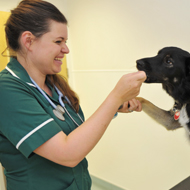Vets warned over rise in feline cowpox cases

"In every photo I've been sent of cats with lesions, not one of the vets has been wearing gloves and that really does worry me." (photo courtesy of
Danièlle Gunn-Moore)
Danièlle Gunn-Moore)
Veterinary surgeons are being urged to protect themselves after a reported rise in the number of feline cowpox cases across the UK.
At a meeting of the International Society for Companion Animal Infectious Diseases (ISCAID) in Bristol last month, several clinicians noted the atypical severity of of skin lesions in a number of cases seen across the UK this year.
Cowpox cases generally peak in autumn when there are the greatest number of reservoir hosts, which include bank voles, field voles and wood mice. It most commonly enters the skin through a bite wound from an infected rodent.
 Prof Gunn-Moore is concerned that veterinary surgeons could be putting themselves at risk of becoming infected.
Prof Gunn-Moore is concerned that veterinary surgeons could be putting themselves at risk of becoming infected.
Danièlle Gunn-Moore, a professor of feline medicine at the University of Edinburgh, said PCR testing of the hard necrotic material also suggests the areas are highly infectious.
Prof Gunn-Moore is concerned that veterinary surgeons could be putting themselves at risk of becoming infected.

Cases now appear to be presenting with large areas of focal dermal necrosis and/or extensive erythema and oedema. (photo courtesy of Julia Henken)
For those that are not immunosuppressed it may only cause pockmarks which will scar, she said, but for those who are asthmatic, atopic, have eczema or are immune compromised, infection could cause serious illness and even prove fatal.
Professor Gunn-Moore is advising vets to wear gloves during the autumn when treating cats, especially those with skin lesions. If there is any wetness and/or coughing in addition to the lesions, a mask should also be worn.



 Zoetis is to present a CPD event for free to members of the British Veterinary Nursing Association (BVNA).
Zoetis is to present a CPD event for free to members of the British Veterinary Nursing Association (BVNA).